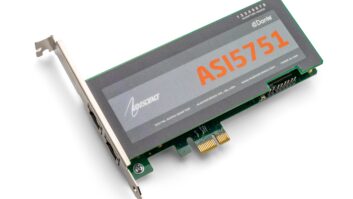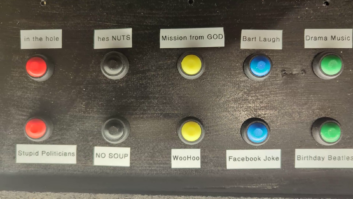Sound all around
Nov 1, 2004 11:21 AM, By Chriss Scherer, editor
The development of IBOC technology has spanned more than 10 years. We are now seeing IBOC systems deployed, and several major groups have committed to installing HD Radio equipment in a majority of their stations. The technology itself is seeing greater acceptance from some of its long-time opponents. One promise of IBOC is that it will provide enhanced services compared to the analog technology it will replace. Until a year ago, the technology had little to show on this promise. The available enhancements were about equal to existing technology. This is no longer the case.

IBOC’s data capabilities have received new-found attention, and ongoing tests of multichannel audio show that IBOC is already evolving. While some still consider it flawed technology, the resources being devoted to make IBOC a viable source of audio entertainment to today’s media consumer are propelling HD Radio forward.
Consumers have embraced surround sound in their homes. A Jupiter Research study shows that 24 percent of American homes have a surround-sound system already installed. Forecasts show that the penetration of surround-sound systems will steadily increase. As consumers expect to hear surround sound material, several companies are looking at IBOC as the delivery vehicle for surround sound to keep radio current with consumer expectations.
Work has begun to implement surround sound into the HD Radio system. Four companies have identified this opportunity, and they are working to see surround added to the list of HD Radio enhancements in pursuit of finding the killer app for IBOC.
Strict definition
The term “surround sound” is not strictly defined. There are several systems available that provide multiple audio channels of information for playback over a system with speakers distributed around a listening sound field. All the surround systems use a low-frequency channel to provide the deep bass of the listening experience. Because of the omnidirectional properties of low frequencies, this deep bass channel feeds a single subwoofer that is usually placed near the front of the sound field. From there, five, six or seven speakers can be placed around the listener to provide the surround soundfield. The subwoofer provides the .1 element of a 5.1, 6.1 or 7.1 system.
There are two general approaches to providing surround sound audio. The multiple channels of audio can be carried through a system as discrete elements. A 5.1 audio system would need six discrete audio paths. The other approach is to use an encoded signal to carry the surround information. One example of this is matrix encoding, which takes into account the amplitude and phase differences of the various audio channels. The matrix approach reduces the number of discrete paths needed to transmit a signal and has been tried several times in the past with mixed results.
Moving ahead with surround sound technology for IBOC, the four companies that are developing systems are SRS Labs, Neural Audio, Fraunhofer and Coding Technologies. All four systems are different, and accomplish the surround effect in different ways.
The Neural and Fraunhofer systems were demonstrated at NAB2004. SRS received Ibiquity’s approval for compatibility with the HD Radio system in June. Coding Technologies unveiled its system at the 2004 NAB Radio Show. All four systems are different technically.
Neural Audio
Neural Audio has partnered with Harris to produce products based on Neural’s technology. The product that applies to surround sound for IBOC is the Harris Neustar 5225. This processor accepts a 5.1 audio stream and creates a stereo signal with a watermark that is used to reconstruct the surround signal when it is decoded.
The resulting stereo audio and watermark stream can be transmitted through a stereo signal path. Additional mono or stereo audio can be mixed with the watermarked audio without affecting the watermark. This enables a station to add audio elements, such as an announcer’s voice, to the surround source. When decoded, the surround material remains intact, as do the mono or stereo elements that were added.
Once transformed into the two-dimensional version, the azimuth of the original 5.1 image envelope is represented by inter-channel intensity differences. The depth of the original image envelope is represented by average inter-channel coherence. Neural believes that intensity/coherence watermarking is the ideal choice because of its similarity to the image construct of naturally occurring two-dimensional stereo while providing stereo compatibility.
On the decoder, the 5.1 image is restored by a programmable, transform-based spatial rendering system, called a Spatial Environment Engine (SEE). The SEE can render any two-dimensional audio source into a signal with two to 256 outputs.
An on-air demonstration of the Harris/Neural system was created by KUVO in September. See KUVO in Surround on page 4 for more.
Telos/Fraunhofer
The level difference, time difference and coherence between channels creates the perception of a spatial image. While transmitting discrete surround channels would preserve the surround sound field, transmitting multiple channels requires substantial bandwidth, which is not possible with IBOC. The Fraunhofer method relies on a stereo mix for the significant part of the bitstream, with an ancillary data stream to provide the surround sound when decoded. The process begins with a 5.1-channel audio feed. A stereo version is created from this stream, which can be done manually or automatically. An encoder then creates the ancillary surround data by comparing the stereo and 5.1 versions to estimate the values as a function of frequency within several sub-bands.

New methods of metering will be required for surround sound.
The result is that the 96kb/s FM channel carries two elements: an 80kb/s stereo encoded stream, which can be played on a stereo IBOC receiver, and a 16kb/s ancillary data stream that is used to recreate the surround sound. There are no changes to the basic codec, so the stereo portion remains intact. This division of the data stream is similar to the method used in the Tomorrow Radio Project to create two independent audio streams. The system uses High-Efficiency Advanced Audio Coding (HE-AAC).
Orban/Coding Technologies
Having debuted at the NAB Radio Show, Coding Technologies has entered into the IBOC surround area, and has partnered with Orban to do it. Coding Technologies, a company that specializes in enhancing perceptual audio encoders with its Spectral Band Replication technology, has developed the “plus” of AAC Plus and the “pro” of MP3 Pro. Coding Technologies also worked with Ibiquity to develop the HDC codec used in HD Radio.
Because this system is based on HDC, Coding Technologies touts that the surround system is fully compatible with the existing codec, eliminating the need to add hardware or software elements to decode the surround information.
Similar in approach to the Fraunhofer method, Coding Technologies uses a stereo downmix to provide compatibility with stereo receivers, and adds a data stream that contains the information needed to create the surround channels when the decoder is present. The main difference is that while Fraunhofer locks the rate of the stereo and surround streams, Coding Technologies allows the streams to be dynamic in their bit allocation without exceeding the 96kb/s limit. This allows for greater flexibility in the datastream application.
Coding Technologies notes that its system is designed to handle surround or the multichannel Tomorrow Radio system being tested by NPR.
Orban and Coding Technologies are working together to ensure that HDC surround can be deployed within a modern digital radio station without a complete overhaul of the existing stereo infrastructure.
SRS Labs
SRS has developed a technology called Circle Surround, which can encode 6.1 channels of discrete audio for distribution over two-channel carriers. SRS Labs has built relationships with major broadcasters, who are providing some television broadcasts in Circle Surround. In addition, SRS has agreements with Kenwood, Marantz, M-audio and other manufacturers to provide Circle Surround decoders in playback equipment. Circle Surround and Circle Surround II encoding is compatible with mono and stereo playback.
Surround scorecard Currently, four companies are pursuing systems to provide surround sound for IBOC.
- Coding Technologies, through its partner Orban
www.orban.com - Fraunhofer, through its partner Omnia Audio
www.omniaaudio.com - Neural Audio and Harris
www.neuralaudio.com - SRS Labs
www.srslabs.comSRS has also worked with Ibiquity to obtain a certification of compatibility with HD Radio. The certification process began about two years ago.SRS states that Circle Surround encoding can be distributed via a bit-rate as low as 48kb/s, but states that 128kb/s will provide maximum separation. At 64kb/s, a station could transmit a surround signal with some separation in the main signal and use the Tomorrow Radio secondary channel as well.Circle Surround is a matrix encoder, using a summing and difference network to downmix the surround signal into a stereo format, which includes a bias signal that is used to reconstruct the surround information when decoded. Additional stereo information can also be added to the encoded stream.On playback, the decoder detects the surround-encoded information in the stereo signal by analyzing the ratio between correlated information and anti-phasic surround material inserted by the encoder. This ratio is generally much higher in an encoded stereo signal than in a nonencoded signal.From theory to application All four of these systems are similar in that they create a stereo version of the surround source and add some additional element to reconstruct the surround information when decoded. This approach ensures compatibility on stereo systems if the surround decoder is not available. With IBOC surround in its infancy, this design allows the HD Radio system to continue its stereo introduction without compromising the ability to add surround later.For broadcasters, backward compatibility is ideal for existing facilities with a stereo infrastructure because tripling the audio channel capability for discrete 5.1 is not an easy task.With four companies developing potential systems, there could be a conflict in deploying them in consumer devices. Stations can only implement one system for transmission. If all four prove to be viable, it is possible that consumer receivers will only be able to decode one or two of the formats. One possible solution to this problem would be a software-defined receiver that would automatically sense and decode the proper system.Surround illustration base and concept courtesy of SRS LabsMeter image courtesy of DK-Technologies












